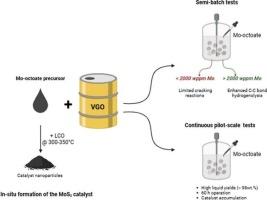Slurry-phase hydrotreating of vacuum gas oil with Mo-based dispersed catalyst in semi-batch and continuous reactors
IF 7.7
2区 工程技术
Q1 CHEMISTRY, APPLIED
引用次数: 0
Abstract
In this study, we investigate the use of Mo-based dispersed catalyst, using oleo-soluble Mo-octoate as precursor, for the slurry hydrocracking of VGO as model feedstock in both semi-batch and continuous slurry reactors. The in-situ formation of the catalyst from the corresponding precursor investigated under reaction conditions with Light Cycle Oil (LCO) as feed demonstrates that Mo sulfidation occurs rapidly between 300 and 350 °C, leading to the formation of MoS2 nanoparticles of hexagonal structure with laminar morphology. Thermal and catalytic semi-batch tests at varying Mo concentration and reaction time indicate that the hydrodesulfurization reactions are catalytically-driven, while cracking follows the thermal free-radical reaction mechanism. At Mo concentrations ≤ 2000 wppm, the active hydrogen formed by the catalyst quenches the free radicals thereby restricting the cracking reactions, while at loadings > 2000 wppm Mo, MoS2 partially contributes to cracking via C![]() C bond hydrogenolysis. Continuous pilot-scale tests for over 60 h showed no operability issues, achieving high liquid yields (> 98 wt.%). Variation of the sulfur removal and cracking extent with time-on-stream suggests partial catalyst accumulation in the slurry reactor during operation.
C bond hydrogenolysis. Continuous pilot-scale tests for over 60 h showed no operability issues, achieving high liquid yields (> 98 wt.%). Variation of the sulfur removal and cracking extent with time-on-stream suggests partial catalyst accumulation in the slurry reactor during operation.

半间歇连续反应器中钼基分散催化剂对真空气相油的浆相加氢处理
在这项研究中,我们研究了使用钼基分散催化剂,以油溶性钼-八酸盐为前驱体,在半间歇和连续浆体反应器中作为模型原料,用于VGO的浆体加氢裂化。在轻循环油(LCO)为进料的反应条件下,研究了相应前驱体的原位生成催化剂,结果表明,Mo在300 ~ 350℃之间快速硫化,形成了具有层状六边形结构的二硫化钼纳米颗粒。不同Mo浓度和反应时间下的热催化半批试验表明,加氢脱硫反应是催化驱动的,而裂化反应遵循热自由基反应机制。在Mo浓度≤2000wppm时,催化剂生成的活性氢能够淬灭自由基,限制裂解反应;2000 wppm Mo, MoS2通过CC键氢解部分促进裂化。连续60多小时的中试测试显示,没有操作性问题,实现了高产液率(>;98 wt. %)。脱硫和裂化程度随运行时间的变化表明,在运行过程中,浆料反应器中存在部分催化剂积累。
本文章由计算机程序翻译,如有差异,请以英文原文为准。
求助全文
约1分钟内获得全文
求助全文
来源期刊

Fuel Processing Technology
工程技术-工程:化工
CiteScore
13.20
自引率
9.30%
发文量
398
审稿时长
26 days
期刊介绍:
Fuel Processing Technology (FPT) deals with the scientific and technological aspects of converting fossil and renewable resources to clean fuels, value-added chemicals, fuel-related advanced carbon materials and by-products. In addition to the traditional non-nuclear fossil fuels, biomass and wastes, papers on the integration of renewables such as solar and wind energy and energy storage into the fuel processing processes, as well as papers on the production and conversion of non-carbon-containing fuels such as hydrogen and ammonia, are also welcome. While chemical conversion is emphasized, papers on advanced physical conversion processes are also considered for publication in FPT. Papers on the fundamental aspects of fuel structure and properties will also be considered.
 求助内容:
求助内容: 应助结果提醒方式:
应助结果提醒方式:


